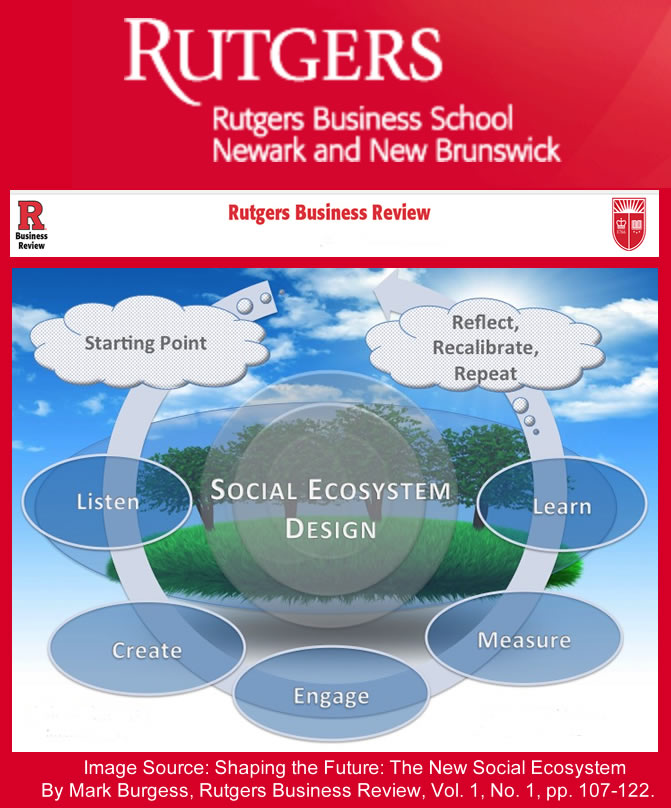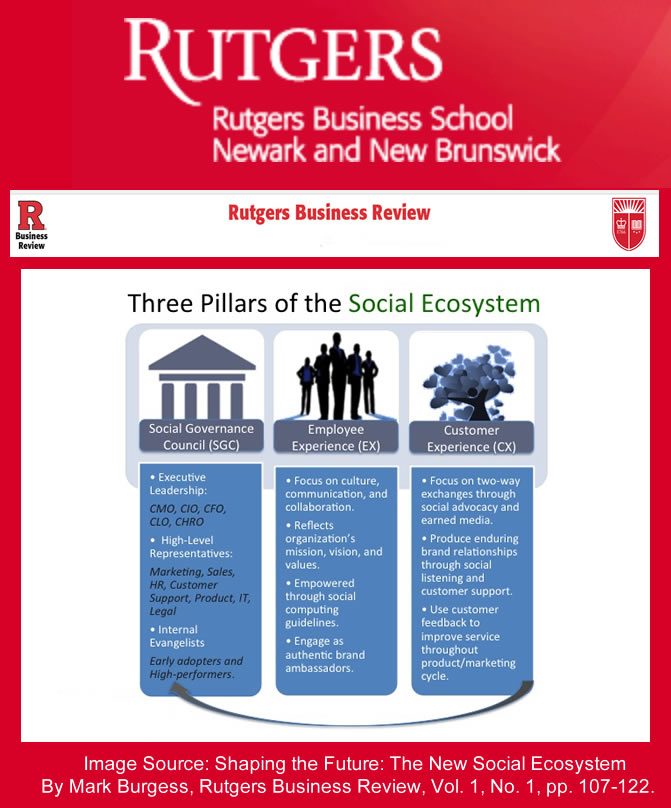
The transformational trend of social business is disrupting and revolutionizing large and small businesses alike as the world becomes increasingly more interconnected, rewired and reoriented by social technology. Businesses are in the midst of fundamental changes that will neither reverse for stragglers nor offer them mulligans. Innovative leaders must rethink their social strategies and move beyond the linear, process-driven approach to dynamic, collaborative, networked organizations. Executing these changes may prove difficult, but it’s imperative for forward-looking organizations to be competitive in the global bazaar of the digitally powered landscape.
What Does Social Business Really Mean?
Social businesses implement social technologies, strategies and processes that span across their entire enterprise, creating and optimizing collaborative ecosystems of employees, customers, partners, suppliers, communities and stakeholders in a safe and consistent way. To transform into a social business, companies need to have more than a mere linear presence on Facebook, Twitter, LinkedIn, Google+ and blogs.
To achieve this, successful businesses must align their core goals and objectives in cross-enterprise collaboration and create a socially integrated organizational blueprint that focuses on people and culture.
Reason for Social Business?
Simply put, unless a company communicates well internally, it will not be able to communicate its brands effectively to the public. Social business deepens internal and external business relationships, which builds brand awareness and in turn drives profits. Companies that embrace social business will build stronger relationships and make better decisions with their employees, business partners and customers.
The State of Social Businesses
This dynamic business model is still in its infancy stage, but this tectonic shift in approach will eventually integrate itself across entire enterprises. As the social networking phenomenon continues to grow exponentially, more forward-thinking organizations will embrace social business’s “holistic” approach to communication.
Humanizing Future Businesses & Brands
Before a business can humanize its brand, it is imperative that it humanizes its business first. This process involves more than just meetings, lunches, phone calls, emails, golf outings or office parties. Instead, such an evolution requires the adoption of social behaviors and communication in every facet of the organization. People don’t think of a brand as a series of departments. Rather, they think of a brand as a whole entity. Businesses must live up to this perception and restructure both internally and externally in order to function as a cohesive unit.
What is a Social Brand?
Social brands are the sum total of the entire customer experience. Marketers constantly struggle to humanize their brands and seize upon opportunities to engage customers across a multiplicity of touch-points and social media channels. Scott Goodson in an article for Forbes claims, “It’s not just about ‘going social.’ It’s about becoming a social business. It’s realizing that marketing doesn’t work like it used to. Today, successful brands become social ones.”
Many organizations have evolved into social brands, but few have developed internal social processes. Behind the corporate firewall businesses are scrambling to engage effectively with their consumers. Despite their frantic efforts, however, their lack of internal communication and processes inhibits sustainable growth. Inconsistency in ROI measurement, corporate governance, culture, technology, executive endorsement and internal conflict have created a great deal of chaos in many companies which lack the necessary social infrastructure.
Tearing Down Silos & Boundaries
This paradigm shift requires organizations to tear down the silos that keep them from creating future brands that are social, engaging, agile and rife with purpose. The same principles of trust that consumers demand from their preferred brands also apply to the way companies must learn to trust their employees.
Businesses must better define their employees’ roles and responsibilities, encourage cross-departmental communication and collaboration, build trust and encourage a culture of recognizing employees’ skills and talents, connecting metrics with objectives, training and educating, developing governance and policies, crowdsourcing creativity and innovation, and using a collaborative process-driven approach for selecting new technology.
It is imperative that the “turf wars” and dysfunctional deep-rooted behavior that exist between many CMOs and CIOs must cease. As I wrote in my article, “Quest for the Marketing Technologist,” the era of digital engagement demands collaboration between CMOs and CIOs in order for companies to remain competitive and relevant. “It isn’t about making the marketing team or the IT team look smarter, it is all about satisfying the customer’s needs better than the competition.” The effective implementation of social business will improve efficiencies and productivity not only in marketing and IT, but also in the supply chain, HR, sales, marketing, financial, research, etc. Interconnected organizations will reap the rewards.
We’re in an era of collaboration, regardless of the size of our businesses; companies need to leverage collaboration to become more efficient, innovative and creative. I can think of no better example of effective collaboration than this video clip from the movie Apollo 13, where the seemingly impossible task of putting a square peg into a round hole became possible through the Apollo team’s effective, dynamic efforts.
Is Social the Future of Business?
In my article, “2012 Social Media Business Trends – Is Social the Future of Business”?, I stated that the migration process from social media to social business will vary depending on the nature, size and strategy of your business. Regardless, the change will happen, and it is in your best interests to begin learning about some of these emerging social trends and tools as you consider how to capitalize on opportunities and achieve your business goals.
In the future, big companies will need to start acting more like smaller companies by connecting all their employees in order to achieve the unified vision of a social business. Conversely, small businesses have an advantage over their larger counterparts. Since both culture and people are essential to social business, small businesses can adapt easier because of their flexibility and ability to change quickly. In today’s digital market, small businesses may function with only a few employees, but their audiences may number in the thousands. Small businesses can leverage social business via their network of business alliances, suppliers, vendors, sub-contractors, freelancers, interns and customers.
Businesses Getting Personal.
In a survey conducted by AIIM, over 50% of organizations consider social business to be either imperative or significant to their business goals. Companies like IBM, Nokia and Ford are fast becoming social businesses by restructuring to put social media at the heart of their business, encouraging internal collaboration and communication and insight sharing. IBM’s white paper, “The Social Business,” states that “Social Business can orchestrate and optimize new ways of generating value through innovation, creativity and utilizing the right skills and information at the right time.”
“People don’t do business with companies.
People do business with people.”
Source: IBM
IBM’s belief is that it takes networks of people to create business value.
IBM’s definition has three tenants that underpin its social business:
A Social Business is engaged—deeply connecting people, including customers, employees and partners, to be involved in productive, efficient ways.
A Social Business is transparent—removing boundaries to information, experts and assets, helping people align every action to drive business results.
A Social Business is nimble—speeding up business with information and insight to anticipate and address evolving opportunities.
Why is Social Business so Relevant to my Company?
The Social Business Forum answers this question by pointing to the extensive studies that show how social business can accelerate organizational efficiency both internally and externally. A few of the internal benefits include: stronger employee engagement and motivation, better business performance, small travel expenses, richer cross-department collaboration, stronger outcomes from knowledge intensive work, facilities for collective social capital and limiting duplication of effort, etc. Benefits outside your organization include: reduced customer care costs, improved client satisfaction and loyalty, increased lead generation, shorter sell cycles, improved cross-channels to customers, etc.
Fundamental Change
Social business is shaking the foundation of both large and small businesses. While change is never easy, companies that implement the best social media business practices and migrate from rigid to social business models will win in the end. The new social landscape is rich with opportunities as companies are challenged to elevate their relevance and become social businesses.
Jeremiah Owyang, Altimeter Group, shared his latest research on the “State of Social Business”:
This post was originally published on AT&T’s Networking Exchange Blog.













Couldn’t agree more with all your points about the transformational nature of social business. The discussion around effective employee engagement preceding or accompanying effective social brand engagement is something we believe in, which we explained in a post “360 Social Business Engagement – consumer *and* employee”.
But what really grabbed my attention was around the experience of brand and it’s relationship to social strategy for the business as a whole. I think we’re lacking a good “engagement beyond transaction” model for brand experience. We’ve tied such a model together with the concept of “Brand Resilience” which you might find interesting http://igo2group.com/blog/social-strategy-brand-experience-depth-breadth/ – we extend brand experience beyond depth to breadth, and link that to the concept social business strategy as explained by you in your post.
Walter @adamson
@igo2 Group
Hi Walter,
Really appreciate your great comments!
Social business is an important part of the process bringing brands closer to customers. Years ago it was all about a transactional experience and now its about building relationships.
Thanks,
Cheryl
Now that is a GREAT overview of a topic that is literally changing our world. I LOVE this change, though I tend to dislike change inherently. I just wish the speed of it all would slow down for this middle-aged dude!
Bruce,
Glad you liked the article!
Everything does seems to be accelerating but in this case, for companies who pursue social business solutions, maybe for the better.
Cheers,
Cheryl
what a great post. best thing i have read in ages.
Amen Cheryl! The real revolution in social media is the way it opens the door to completely changing the way we run our organizations. In our book Humanize, Maddie Grant and I identified four more human elements to guide our cultures, processes, and behaviors: open, trustworthy, generative, and courageous. These are the same principles that have been driving social media’s grand success. We’re drawn to them because they are at the core of what it means to be human. Now it’s time to make our companies and organizations that compelling!
Thank You Jamie!
Great post Cheryl.
I think it’s important for companies to be aware of the range of tools that can put them on the right track to being a social business but more importantly it’s vital for them to understand the behaviour and culture required to use these tools effectively. An open culture.
Without a change in an organisation’s culture, these tools won’t get internal take-up and won’t be used to their full potential.
Thanks.
Jason
Jason,
Thank You!
Cheryl